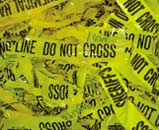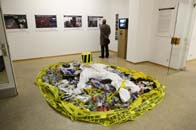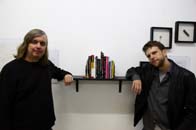
If you have
questions, wish press material about Art Laboratory Berlin
or specific projects,
or would like to arrange an interview our Press and Public Relations Department
is glad to help you.
Christina
Korzen, Press and PR
presse@artlaboratory-berlin.org
|
Art
and Law III Film
Screening: Strange Culture, 2. November 2009, 7.30 PM Catalog:
Regine Rapp and Christian de Lutz for Art Laboratory Berlin (Hrsg.):
|
photographs |
|||||||
 |
 |
 |
|||||
|
Critical
Art Ensemble (CAE) is a collective of tactical media practitioners
of various specializations including computer graphics, software,
wetware, film/video, photography, book art and performance. CAE
was founded in 1987 and has produced a wide variety of projects
for an international audience at diverse venues ranging from the
street, to the museum, to the Internet. The
Institute for Applied Autonomy (IAA) was founded in 1998 as
an anonymous collective of engineers, designers, artists and activists
united by the cause of individual and collective self-determination.
Toward this end, the IAA has produced numerous projects under its
flagship initiative, Contestational Robotics. These include several
tele-operated robotic graffiti writers; I-See, which gained worldwide
media attention as a web-based navigation service to help users
avoid surveillance; and Terminal Air, an installation and website
that visualizes the movements of airplanes believed to have been
used in the CIA's "Extraordinary Rendition" program. Strange
Culture documents the surreal nightmare of internationally-acclaimed
artist and professor Steve Kurtz which began when his wife Hope
died in her sleep of heart failure. Police who responded to Kurtz's
911 call deemed Kurtz's art suspicious and called the FBI. Within
hours the artist was detained as a suspected "bioterrorist"
as dozens of federal agents in Hazmat suits sifted through his work
and impounded his computers, manuscripts, books, his cat, and even
his wife's body. The film Strange Culture stars Tilda Swinton, Peter
Coyote, Thomas Jay Ryan, Josh Kornbluth and Steve Kurtz, and was
shown in the 2007 Berlin Film Festival. If
you have any questions or wish material about the exhibition, please
contact Pamina Gerhardt (responsible for Press and Public Relations): --------------- ( Press
release from 9 August 2009) The exhibition Seized documents the FBI raid on the house of CAE member Prof. Steve Kurtz in May 2004, following the death of his wife Hope. In the weeks prior to the raid Steve and Hope Kurtz had been preparing for an exhibition examining GM agriculture at Mass. MOCA. An emergency worker of the fire department responding to Steve Kurtz's 911 call found materials in their house related to the upcoming exhibition suspicious and informed the FBI. The raid, conducted by FBI-officers wearing hazmat suits, and blocking off a half block radius of the home, caused much media attention. Even though Hope Kurtz's death was found to be of natural causes and none of the materials found at the Kurtz residence were found to have any health threat whatsoever, the US Department of Justice sought to charge Steve Kurtz, first with "bioterrorism", and when that was unsuccessful, with 'Wire and Mail Fraud' for receiving harmless bacteria samples. After almost four years the charges were dismissed by Federal Judge Richard J. Arcara as being "insufficient on its face," meaning he found that no crime had been committed. During the raid a number of items pertaining to the Mass MOCA exhibition, as well as other artworks, computers, books, archives and manuscripts were confiscated. The FBI also left behind a substantial amount of garbage - including over 30 empty pizza boxes, several hundred energy drink bottles, hazmat suits, respirator filters, unlabeled biological sample bags, a handwritten checklist culminating in the phrase "sign warrant" and a cigar butt. In the exhibition Seized/ Beschlagnahmt these traces of law enforcement have been combined with documentation of the raid and the court case that followed. In addition the show presents artworks and performances by CAE, including those being worked on by Steve and Hope Kurtz before the raid. In
connection with the exhibition, Art Laboratory Berlin in cooperation
with Arsenal - Institute for Film and Video Art e.V. will screen
the film Strange Culture (2007) by Lynn Hershmann Leeson
on November 2 at the Arsenal Cinema, Berlin, followed by a panel
discussion. The film documents the events of May 2004 and their
aftermath. -----------
The
main focus of interest is the exhibition and placement of contemporary
visual art ART
LABORATORY BERLIN is also interested in supporting contact between
artists and the The current co-directors of ART LABORATORY BERLIN are: Regine Rapp (art historian, curator) and Christian de Lutz (visual artist, curator) Responsible for press and Public relations is Pamina Gerhard (art historian). For
direct information please contact:
|
elle Events:
Information
about Art Laboratory Berlin:
Art
Laboratory Berlin (as.PDF)
Previous exhibitions and events: (click here)
| sponsored by: | ||||||
| in cooperation with: | ||||||
| This exhibition and the catalogue were made possible by an anonymous donor whose wish it is to support projects in the defence of democracy. | ||||||